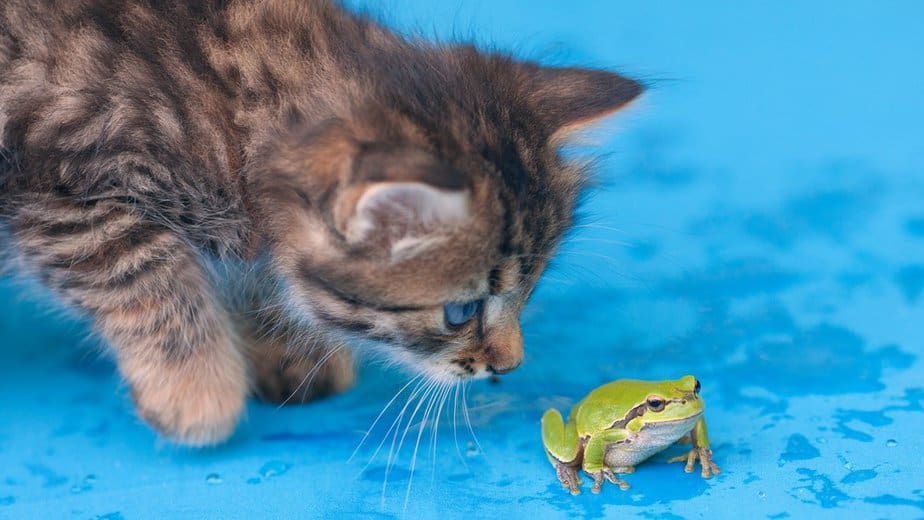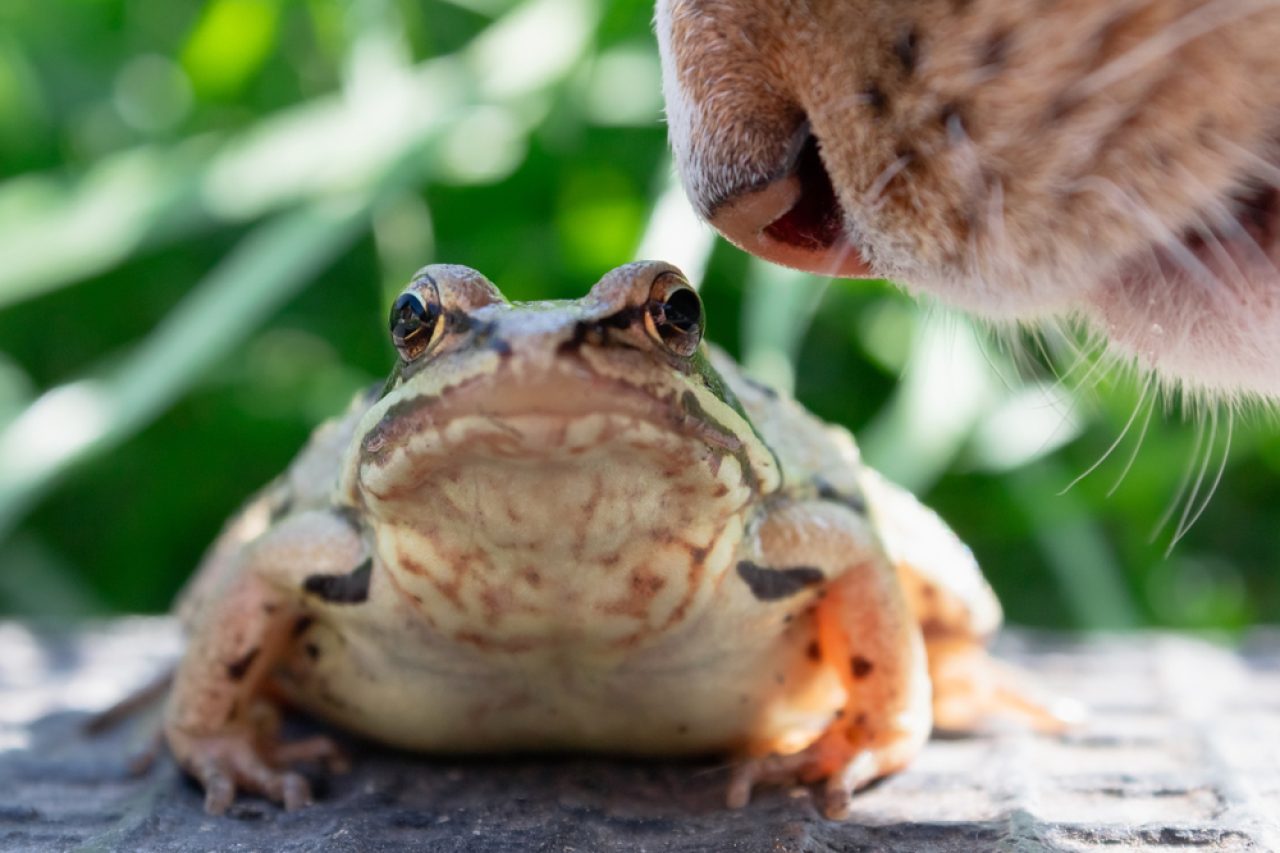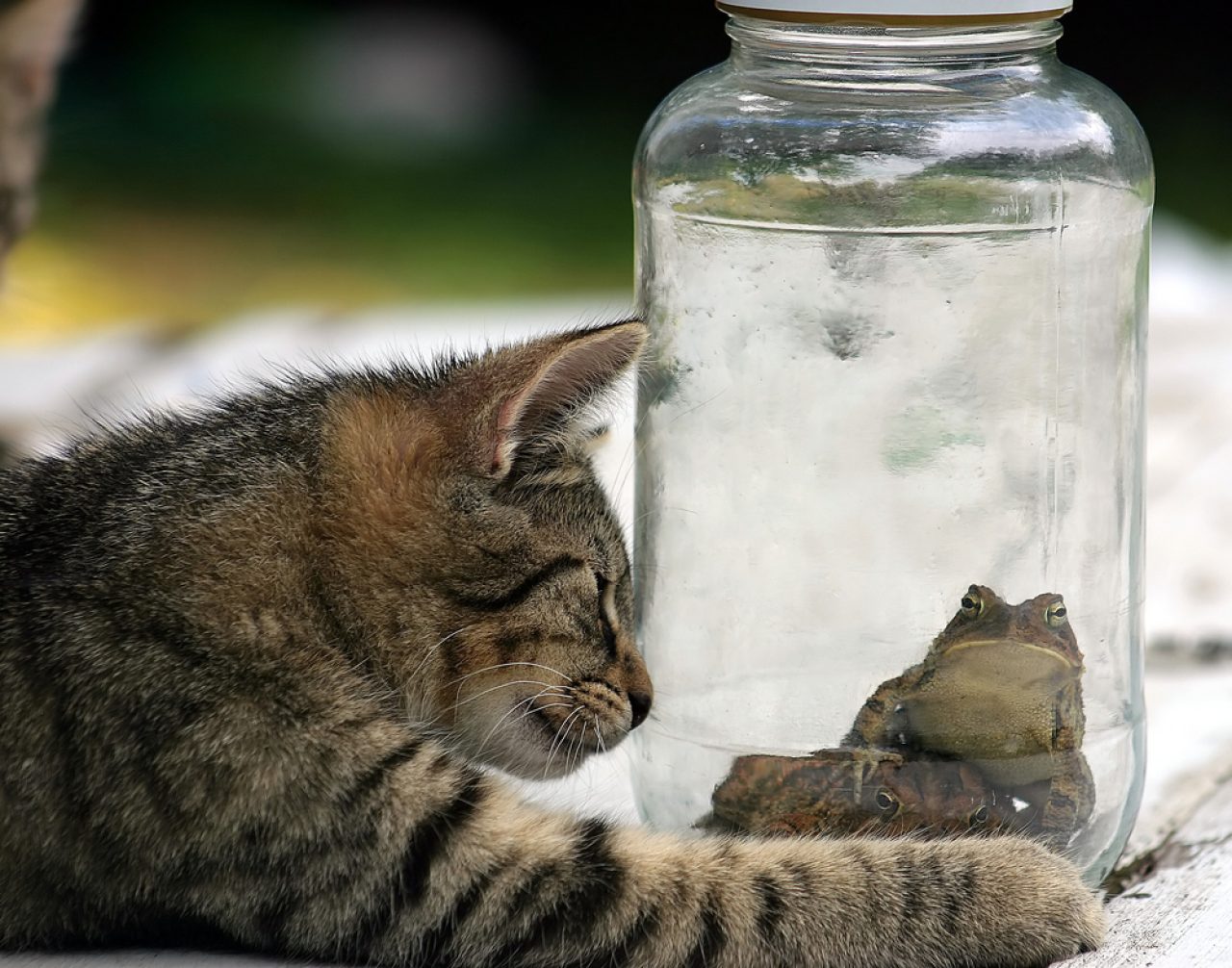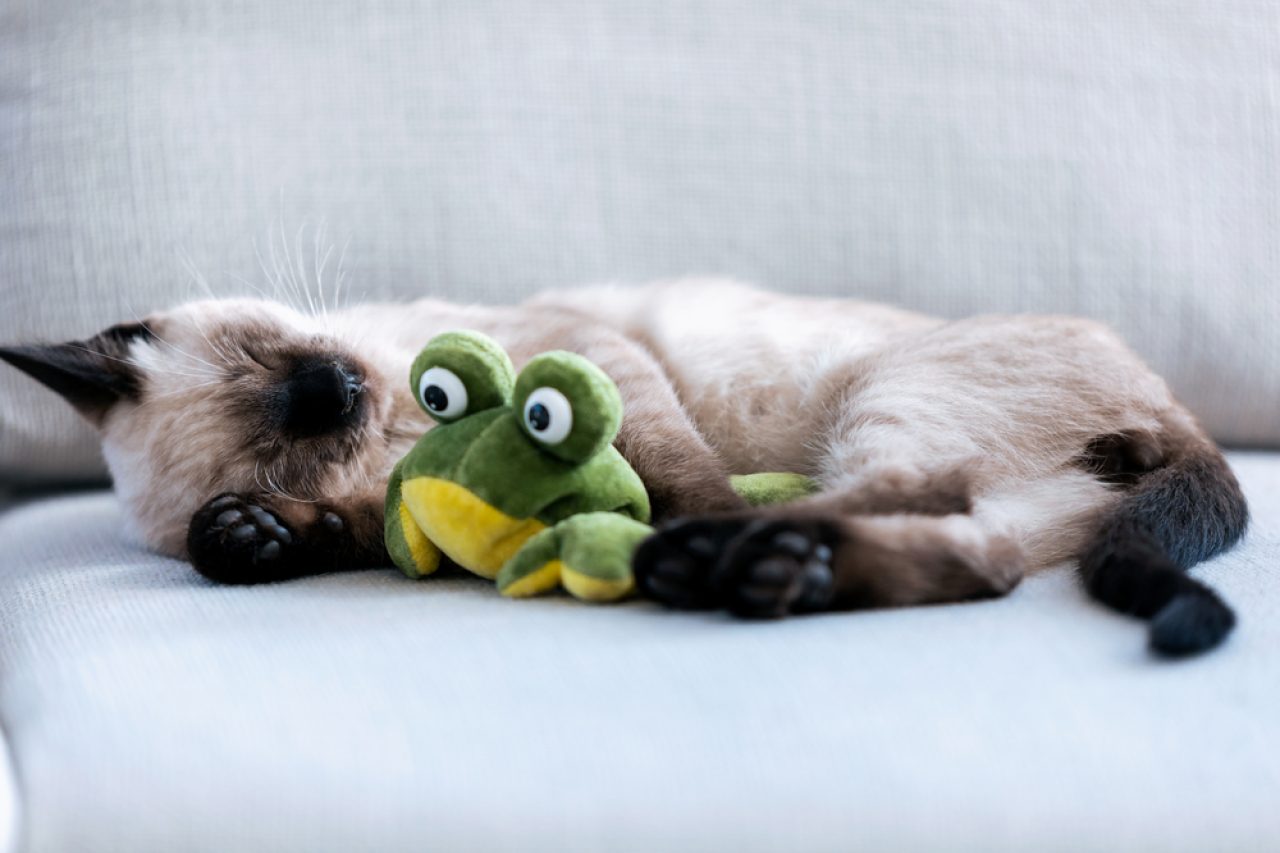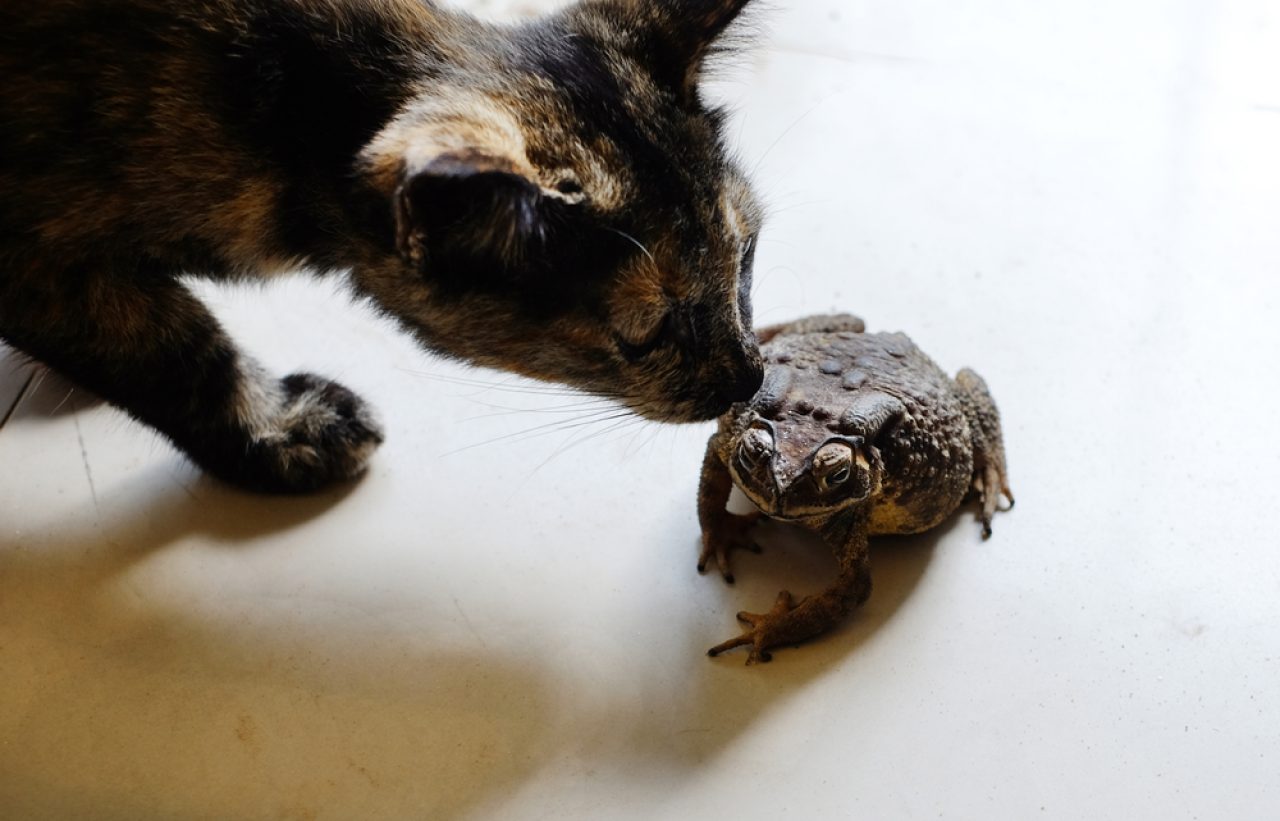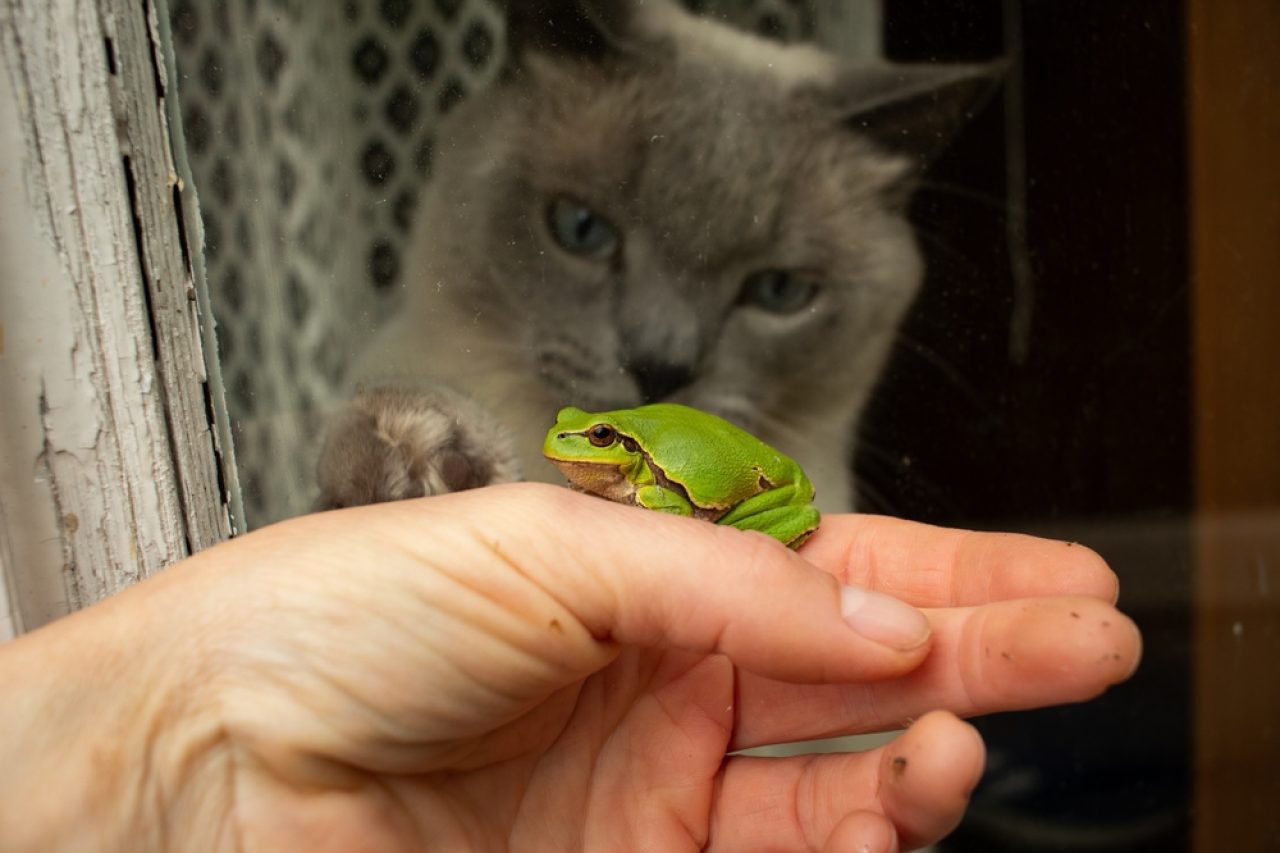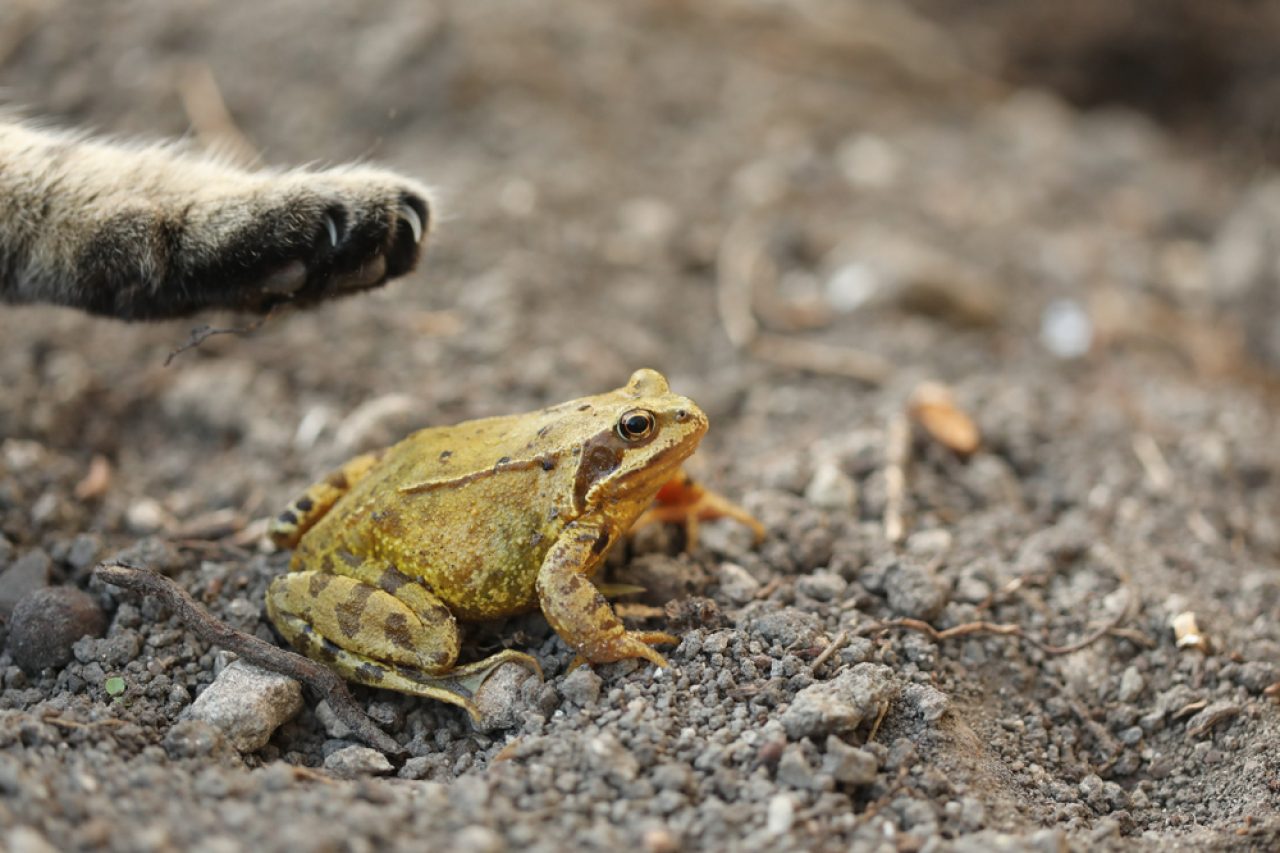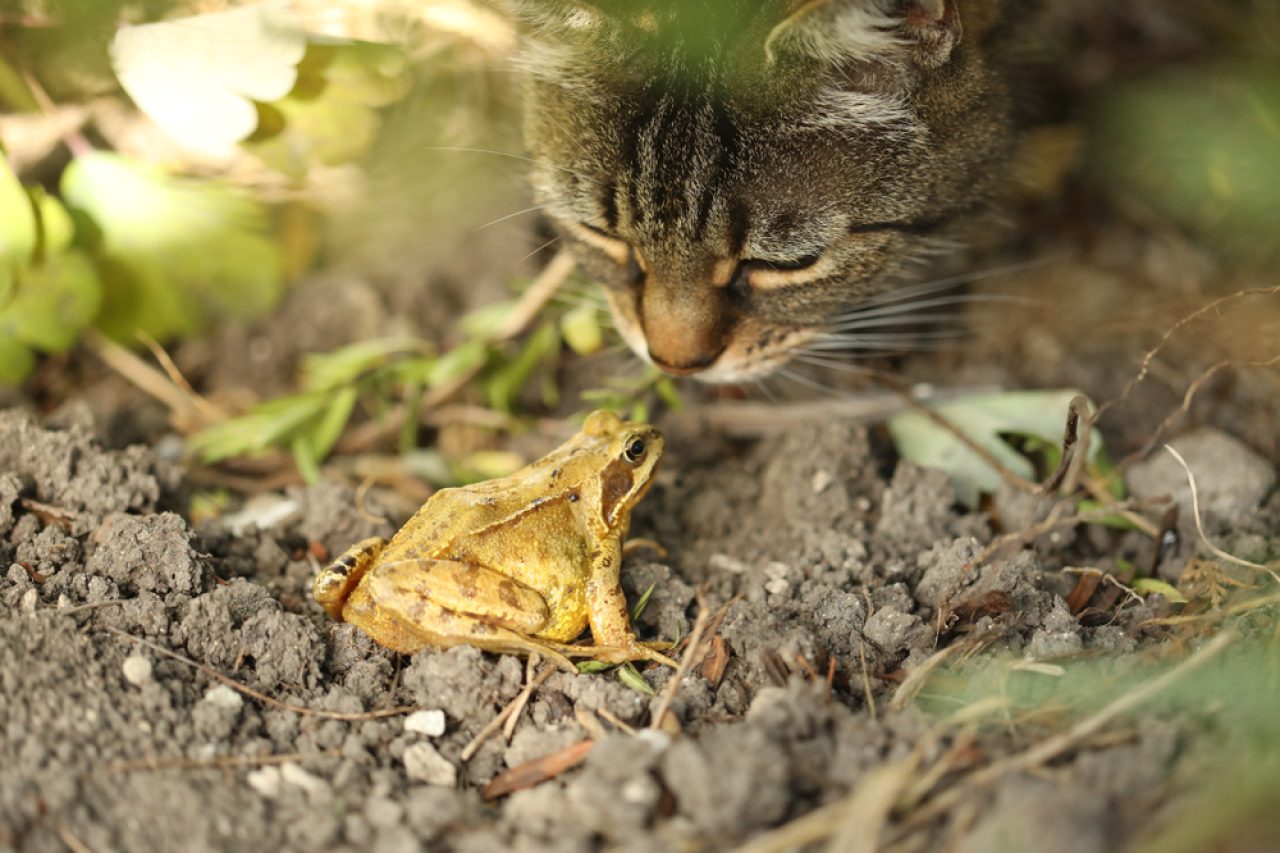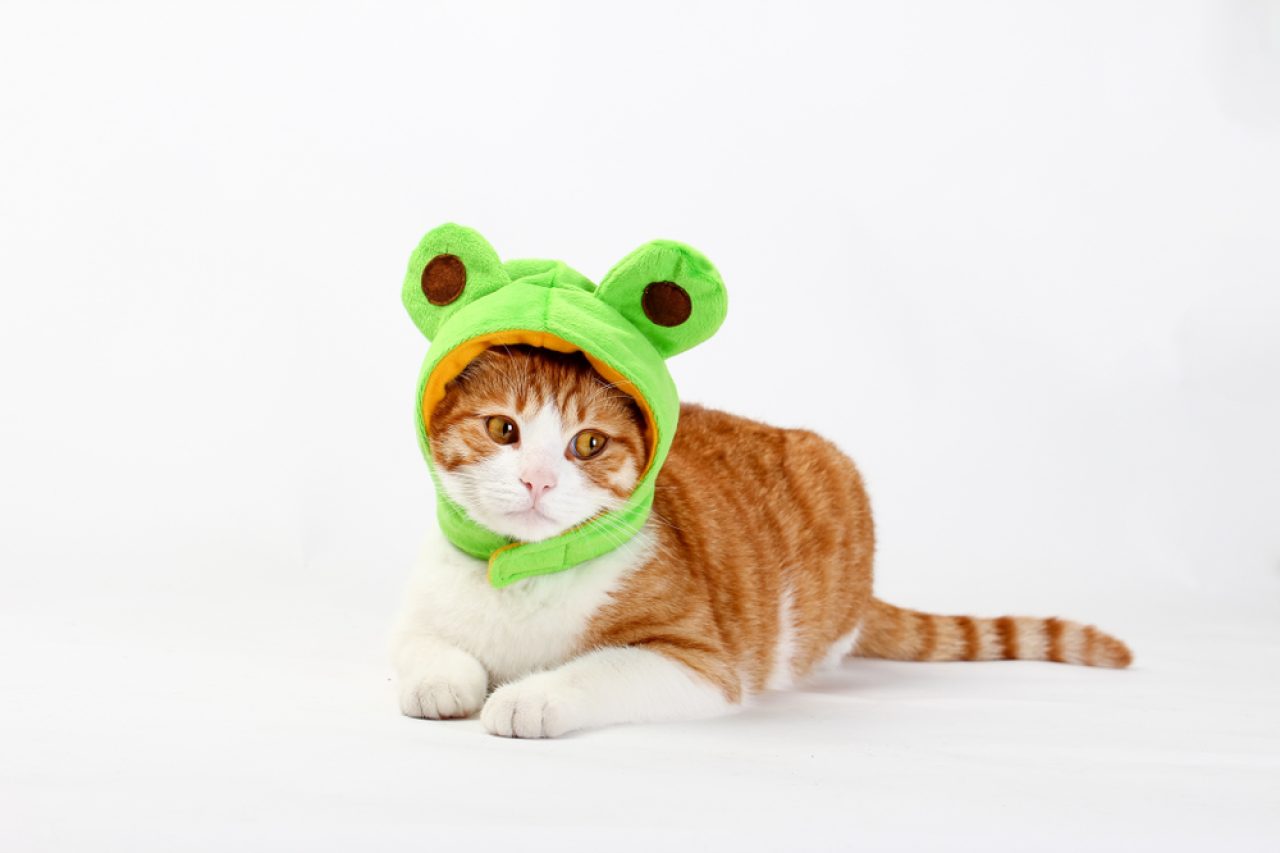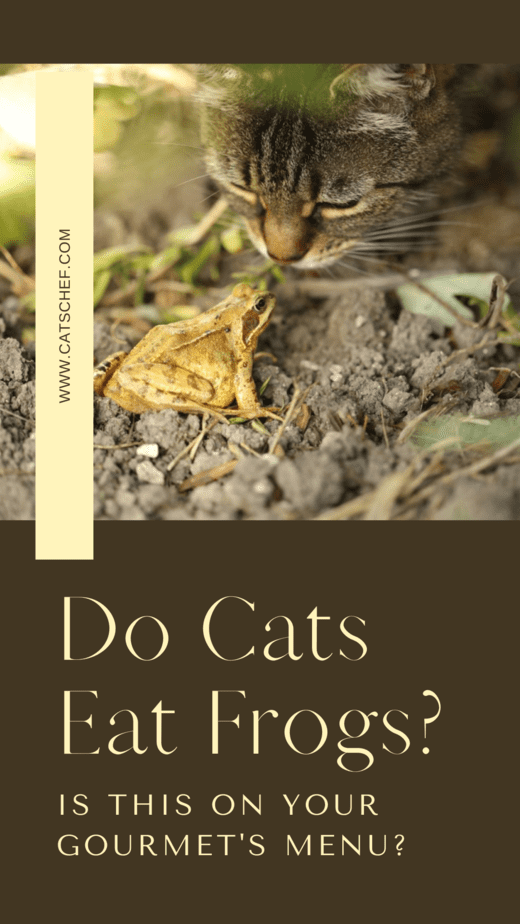📖 Table of Content:
If you’ve been a cat parent for a while, then you’ve probably noticed that your cat will try to eat just about anything. No matter how disgusting it might seem to you, your fluff will act like it’s the most delicious meal on the planet. But, do cats eat frogs? Would they go THAT far?!
Our feline companions have strong hunting instincts that make them want to hunt down anything that moves. And we mean ANYTHING. Throw a plastic bag in the air and watch your pawdator go crazy about it. Now, imagine if your fluff was an outside cat, and she saw a frog hopping around your garden…
If your fluff does spend some time outside, then you’ve probably had the opportunity to see your fluffy hunter in action. You might have even found some gifts of appreciation from your fluff on the doorstep. A cute mouse on your porch is exactly what you needed this morning, and your kitty made sure you got it.
Now, you can’t compare your kitty’s diet to yours, so don’t judge her for her choices. Sometimes, however, our fluffs can get a little ahead of themselves and munch on something that’s not good for them. Let’s see if frogs and toads are one of those things.
Do cats eat frogs?
Cats are well-known for their curiosity, and you best believe they’ll be interested in anything that’s crawling or hopping around your backyard. If you’ve noticed frogs around your house lately, it’s pretty normal to wonder if they’re safe for your kitty.
So, do cats eat frogs? Prepare your stomach, because the answer is – yes, they do. Although frogs aren’t at the top of their list of most delicious meals, our feline buddies might eat one if they get the opportunity to do so.
Although your fluff is more likely to play with a frog than actually eat it, she might get carried away and munch on it a little. Can you blame her? With a frog hopping around your yard, your kitty might see it as the best toy she’s ever laid her eyes on.
Although most cats will simply see it as a toy they can chase around and play with, a nice little frog will be a dream come true for a starving cat. She won’t think twice about eating it. It will provide her with fat, protein, and a bit of carbs. It’s a win for her.
Although just thinking about your sweet feline eating a frog might make you gag, it’s the reality. No matter how tasty the canned food at home is, the wild side of your kitty craves a good hunting session. A nice treat at the end of it is like a reward.
But, how safe are frogs for cats? We might think they can’t be much different than mice, rats, birds, and other small prey our kitties hunt, but is that really the case?
Are frogs poisonous to cats?
If you’re wondering “do cats eat frogs”, you’re probably also worried about them being harmful to your kitty. Luckily, most of the frogs we have hopping around our homes aren’t toxic, but there are still some exceptions.
If you live in a tropical region or around a rainforest, you might have a bit more to worry about, since most of the poisonous frogs live there. Luckily, it’s pretty easy to tell them apart from their non-toxic cousins.
For example, a Poison dart frog has bright skin that comes in various shades of fluorescent blues, yellows, and reds. You can also recognize them by black or white spots or strips.
So, if you live outside a tropical region, you probably have nothing to worry about. However, if your cat ate her four-legged green buddy, it would be best that you check the most common frogs in your area, just in case. Also, make sure you know how to differentiate a frog from a toad, as it can make a huge difference.
What happens if your cat eats a frog?
If you started wondering “do cats eat frogs” because your fluff ate a green buddy from your yard and vomited – don’t worry. It’s a completely normal reaction, even if it’s a non-poisonous kind. Your kitty’s stomach isn’t used to this kind of food. Any change in your fluffs diet might cause this kind of reaction.
Feline’s digestive system wasn’t made to deal with frogs, so your kitty gave her stomach a little surprise. Her tummy, on the other hand, isn’t a huge fan of surprises, especially slippery ones, so it rejected her green treat shortly after she ingested it.
If this is the case, make sure to give your cat plenty of water. Don’t force her to start eating her regular food immediately, as she might vomit that as well. Give her stomach some time to rest and get back to normal. She’s been through a lot, the poor thing.
The most important thing is that your kitty will be okay. There’s no reason for you to panic. If you live in an urban era, the frog your cat ate is probably not poisonous, so don’t hurry her to the vet. It could only put her through more unnecessary stress.
Keep an eye on her, watch for any possible symptoms, and be prepared to clean her vomit. The beauty of being a cat parent…
Are toads poisonous to cats?
Most frogs aren’t poisonous to cats. Toads, on the other hand, could be. The main issue here is that most people can’t see the difference between these two species. So, if you’re asking “do cats eat frogs” because your fluff ate one, make sure that it’s not its toxic cousin, first.
When we think about frogs, most of us imagine them as wet, slippery, long-legged animals that hop around our yards. And we’d be correct. But, if someone asked you to describe a toad, would you use the same imagery? If your answer is yes, then you’d be wrong.
In contrast to frogs, toads have dry skin and short hind legs. The most common poisonous toads are the Colorado River toad, and the Cane toad. Unfortunately, unlike frogs, toxic and non-toxic toads don’t look much different, which is why it can be dangerous if your cat ate one.
Luckily, animals (including cats), usually stay away from toads because they produce mucus that’s not too tasty. However, the two poisonous species we’ve mentioned also produce a milky substance that can be fatal for animals, so it’s best to keep them far away from them.
Symptoms of toad positioning are quite severe and manifest within a few seconds after the encounter. They include:
- Crying or any kind of vocalization of pain
- Eye or mouth scratching
- Your feline’s mouth might change color
- Foaming, drooling, and excess saliva from the mouth
- Difficulty breathing
- High temperature
- Erratic movements
- Seizures
- Collapsing.
Although these symptoms sound scary, the chances of this happening are pretty small, so don’t worry. However, it’s good to know the risks toads can bring, so you know how important it is to keep your kitty away from them.
How to deal with toad poisoning in cats?
When it comes to toad poisoning, it’s crucial to react immediately, as it can save your kitty’s life.
The first thing you should do is wash her mouth thoroughly with clean water. No matter how hard it may seem, it’s important to do this right away. Make sure to remove all the saliva and foaming from her mouth as it can contain poison.
Phone her vet right away and put your kitty in the carrier. If you have the time, take a quick photo of the toad your kitty came in contact with so that her vet knows what they’re dealing with. It will be much easier to show it than to try and describe it to them, as you might miss some important details.
Unfortunately, as for now, toad poisoning has no known antidote or treatment. The only thing you can do until you reach the vet station is to try and reduce the pain your feline is feeling by getting rid of the poison in her mouth.
You’re probably not the first cat parent in the area that’s rushed their dear fluff to the vet station because of this kind of poisoning. Because of that, your vet might already have an idea of what kind of toad and poison you’re dealing with.
A photo you took might help them confirm it so they can prepare a proper treatment for your kitty. Don’t blame yourself for what happened. If you know you’re living in an area that has some poisonous toads roaming around, keeping your cat inside would be the safest option.
How to keep your cat away from frogs?
Maybe instead of asking ourselves “do cats eat frogs”, we should start wondering how to keep them away from them altogether. Not all of us are frog and toad experts, so it’s best to be safe than sorry.
1. Keep her entertained and her tummy full
Our kitties are natural predators, and you can never be sure if your fluff is just playing with her green buddy or planning to eat him when she’s done. So, if she’s eating frogs because she’s bored and hungry, the best thing you can do is keep her entertained and full.
Make sure you spend enough time playing with your kitty. We know, days can get busy and you simply forget that your fur friend needs some attention, too. Use this as an opportunity for the two of you to bond. We’re sure she’ll love every second of it, and so will you.
So, surprise your fluff with some new toys, and let the fun begin. You can even get her some frog ones! Scratching posts, string toys, and balls she can chase around are all amazing choices. The goal is to tire her out enough that she’d rather nap than run around your yard chasing frogs.
After a good playing session, it’s time to give your play buddy some food. It would be ideal to feed her at the time of the day when she usually plays with the green companions in your yard. If she’s feeling tired and full, she won’t have any thoughts about going outside and chasing them.
2. Keep an eye on your predator
If your fluff likes to go outside, make sure you never leave her unsupervised. Even if there are no frogs in sight, it’s still important that you never let your fur baby roam around alone. There are a lot of dangers outside that can seriously harm your kitty, so make sure you always know where she is.
She might even enjoy having you around, and you’ll be safe knowing she’s not doing anything that could harm her. Even if there are some frogs around, you can stop her from eating them if she gets too close. There’s nothing wrong with her chasing her green friends around, but it should always be from a safe distance.
3. Prevent standing water in your backyard
No matter how cute it may look, don’t keep any water in your backyard. That includes fountains, pools, or any other types of standing water. Not only can they be a drowning hazard, but they also attract frogs.
If you have a pool already but you’ve just adopted a kitty, it’s normal to wonder if cats eat frogs because your backyard must be their favorite spot to hang out. I mean, can we blame them? A whole swimming pool just for little green buddies to enjoy; how could they resist?
Well, they can’t, so you have to find a solution how to keep frogs from making your swimming pool their home. Luckily, there are a couple of things you can do, and some of them include:
- Install a fence – a simple yet effective way to keep frogs away from your pool; a simple pool fence could put your mind to rest.
- Use a pool cover – when the pool is out of use, there’s no need for it to be open; covering it won’t only prevent frogs from entering, but it will also keep your cat safe in case of accidents.
- Turn off the lights and keep the water heated.
If by any chance, you already have a pond in your backyard, there’s not really an easy way for you to get rid of it. Plus, it’s probably your pride and joy and the favorite thing about your home. So, the easiest thing you could do is simply keep your cat inside.
If your cat absolutely has to roam outside, then think about relocating the frogs from your pond. Find them a new home, use a net, and scoop them out of their old one. Although it’s a lot more work, it will help you keep your kitty safe.
Conclusion
So, do cats eat frogs? Unfortunately, sometimes they do. Hunting down prey is in their nature, and you can’t expect your dear furbaby to ignore all of her instincts. She’s already spending most of her days cuddled up next to you, she has to let it out somewhere.
However, although they sometimes ingest frogs, it’s best to keep them away. It’s easy to mistake a toad for a frog, and it isn’t really an error you want to make. Some toads can be highly poisonous to our dear feline buddies, so it’s best to avoid them altogether.
